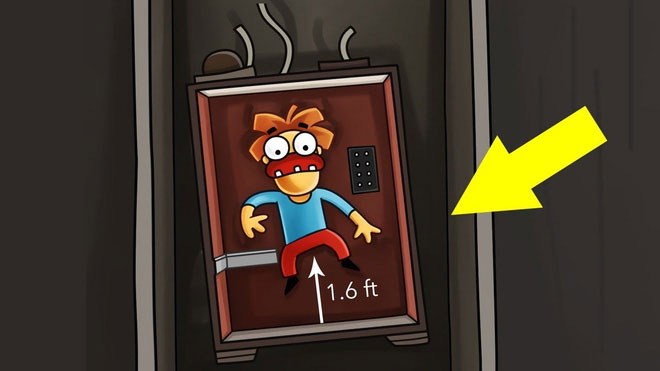“Take the elevator, watch out for broken cables, stuck…”. With this worry, many people “boycott” the elevator, or suffer from fear of elevators. What about reality?
Imagine: you take an elevator, but the elevator suddenly stops, and then somehow the cable car breaks and falls freely.
This is a very familiar scene in some Hollywood action and horror movies. But this short question: can you survive if you jump up at the exact moment the ladder hits the ground?

Your survivability depends on the height of the ladder.
Do a little math and understand right away. Before hitting the ground, the ladder is falling with speed x, and you jump up with velocity y and in the opposite direction. You jump up and have to fall again so your velocity when hitting the ground will be “x – y”.
Here, “y” is not an overly volatile variable, since one’s jumping speed is limited. But “x” is different, it depends on how high the ladder starts to fall, and that is also a factor in determining whether your jump has any effect or not.
Life or death depends on altitude!
Optimistically, let’s say you have an NBA player’s jump, which means you jump about 70cm high. Then below is your survivability depending on the height of the ladder .
- 3m (2-storey house) : Jump at the right time, you will land like falling from a height of 80cm, and there is no danger. The problem is that you only have about 0.8 seconds to act.
- 9m (4-storey house) : Free fall from 9m, the big chance is that you will die. But if you jump at the right time, your landing speed is just like a fall from a distance of 4.7m, and you have changed from “possibly dead” to “injured”. A few bones may be broken, but still alive, and only 1.2 seconds to act.
- 15m (6-storey building) : Jump at the right time, it will be equivalent to a fall from a height of 9m. There’s a good chance you’ll die, but the status also changes from “certainly dead” to “possibly dead”. And the time for you to act is 1.7 seconds.
- 21m (8-story building) : Your landing speed is also equivalent to a free fall from about 14m. Jump or not you will almost certainly die, and you only have about 2 seconds to prepare.
Should I dance or not?

Jumping is difficult, as gravity tends to pull the floor away from you.
In theory, a well-timed jump when the elevator falls does increase the odds of survival. In practice, however, it is extremely difficult to do so.
1s slow, you hit the ground; 1s early, you can plug your head into the ceiling of the elevator, or the jump speed is greatly reduced and makes the jump less effective. Even jumping up is difficult, as gravity tends to pull the floor away from you. If you want to jump, you have to hold onto the support bar to keep your feet on the floor.
But should we dance or not? This fact is still quite controversial even with the scientific world.
Some people think that when the elevator falls, lie on the floor to spread the force more widely, spreading out the whole body. However, others disagree, saying that it also means you are leaving room for the force to affect the brain. And if so, it would be better to take the risk of jumping to let your legs take the load.
What happens if the elevator cable breaks?
In fact, the elevator is one of the safest means of transportation. The reason is that they rely on steel cables, usually four to eight.
Therefore, if one wire breaks, the others can still hold the lift. These cables are designed to withstand the weight of a full person ladder. Therefore, the risk of cable breakage due to heavy loads is very unlikely.
Even if multiple cables are broken in an odd incident, elevators are equipped with additional layers of precautions that can protect passengers.
In the 19th century, Elisha Otis, an American industrialist, developed a safety device to prevent an elevator from falling if the crane cable was damaged . If the power is cut off, the electronic release brake can operate.
Hydraulic shock absorbers are usually placed at the top and bottom of the shaft to make this ascending or descending a bit smoother.
So many layers of safety, why are there still accidents? As noted, most accidents are the result of human error, rather than pure mechanical failure of the elevator.
For the 2018 incident in Chicago, it was clear that many safety precautions were in place. That’s why six people in the elevator car fell down 84 floors without anyone being seriously injured.
Do not worry
Elevator crashes in free fall are now rare. Simply because modern ladders have a lot of backup options, like equipping more cables, or using electromagnetic brakes. In general, the possibility of having to do action movies by yourself is very low, so rest assured.
